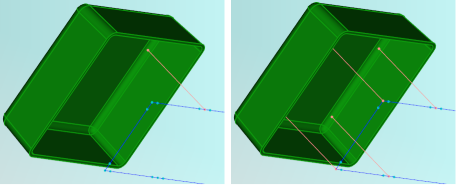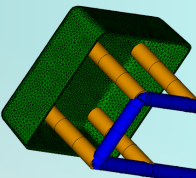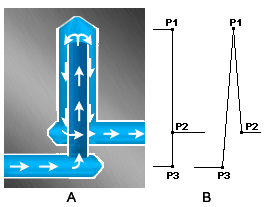To model bubblers - manually
To manually model a bubbler, create a curve specifying the bubbler elements and then mesh the curve.
Note: As an alternative, generate bubblers at time of meshing by extracting center lines from an imported CAD model of the cooling system, and applying the property of Bubbler to the appropriate curves
It is assumed that:
- The cooling channel curves have been defined and a bubbler is to be added to one or more of these curves.
- It is also assumed that there is not a node on the cooling channel curve where the bubbler is to be created.
Note:
For a Cool (BEM) analysis, when cooling elements pass through an insert that has different thermal properties to the rest of the mold, the insert material needs to be specified and applied to those elements.
Nodes may need to be placed on the cooling channel curve at the boundary of the insert so that affected elements and the insert align. Apply a different property to the impacted elements so that the insert material can be easily applied.
Modeling a bubbler with a single channel
Click
 (Geometry tab > Create > Create Node) and place a node on the circuit indicating the base of bubbler.
(Geometry tab > Create > Create Node) and place a node on the circuit indicating the base of bubbler.Click
 (Geometry tab > Create panel > Curves > Create Line) and create a line from the node towards the part. End the curve a distance from the part that is at least equivalent to the outer diameter of the bubbler.
(Geometry tab > Create panel > Curves > Create Line) and create a line from the node towards the part. End the curve a distance from the part that is at least equivalent to the outer diameter of the bubbler.
Select the curve that represents the bubbler. Click Geometry tab > Properties panel > Assign > New > Bubbler.
Enter the bubbler dimensions in the Bubbler Surface Properties tab of the Bubbler dialog.
To prevent excessive pressure in the bubbler, the ratio of inner diameter to outer diameter should be about 0.7.
Enter 1 for the Heat transfer effectiveness (HTE).
Select the mold material from the options in the Mold Properties tab of the Bubbler dialog. If the bubbler is encased in a different material to the rest of the mold, it is important to specify that material.
In the Name box, enter an appropriate name for the bubbler, then click OK twice.
Right-click on the Mesh icon task in the Study Tasks pane and select Define Mesh Density . Set the mesh density to 2.5 times the diameter of your bubbler. Click Apply and OK.
Click
 (Mesh tab > Mesh panel > Generate Mesh), deselect the check boxes, then click Mesh, to launch the Simulation Compute Manager.
(Mesh tab > Mesh panel > Generate Mesh), deselect the check boxes, then click Mesh, to launch the Simulation Compute Manager.In the Simulation Compute Manager, select the solve location, then click Launch..

Modeling a bubbler with dual channels

A indicates the bubbler cross-section and B indicates the mold model representation. The beam element between P3 and P1 is circular in cross-section with Heat Transfer Effectiveness (HTE)=0. The beam element between P1 and P2 is annular in cross section with HTE=1. Orange is the default color assigned to a bubbler.
Click
 (Geometry tab > Create panel > Curves > Create Line) and create a line from the center line of the inlet (P3), to the top of the tube (P1).
(Geometry tab > Create panel > Curves > Create Line) and create a line from the center line of the inlet (P3), to the top of the tube (P1).Create a line from the top of the tube (P1), to the center line of the outlet hole (P2), including a small distance along the axis of the bubbler hole to separate the two new curves.
Select the inner channel (line P1-P3), Click Geometry tab > Properties panel > Assign > New > Channel.
Enter 0 for the Heat transfer effectiveness (HTE).
In the Name box, enter an appropriate name for the bubbler, then click OK twice.
Select the outer channel (P1-P2), Click Geometry tab > Properties panel > Assign > New > Bubbler.
Enter 1 for the Heat transfer effectiveness (HTE).
Specify the required dimensions, mold material, then click OK twice. The inner diameter of the bubbler should be equal to or larger than that of the channel you created previously.
In the Name box, enter an appropriate name for the bubbler, then click OK twice.
Right-click on the Mesh icon task in the Study Tasks pane and select Define Mesh Density . Set the mesh density to 2.5 times the diameter of your bubbler. Click Apply and OK.
Click
 (Mesh tab > Mesh panel > Generate Mesh), deselect the check boxes, then click Mesh, to launch the Simulation Compute Manager.
(Mesh tab > Mesh panel > Generate Mesh), deselect the check boxes, then click Mesh, to launch the Simulation Compute Manager.In the Simulation Compute Manager, select the solve location, then click Launch.

Note: You should leave a gap of at least half of the diameter of the bubbler between the top of the bubbler and your part. This is to allow clearance for the dome at the top of the bubbler.
Tip: You may overlay the two curves if you prefer. If so, it is recommended that during Step 2, you create the second curve (P1-P2) away from the part, assign its properties, then move it so that it is superimposed on the curve (P3-P1).
